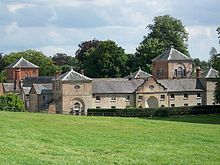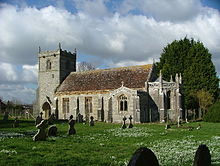- Crichel House
-
Crichel House is a country house located near the village of Moor Crichel in Dorset, England. It is surrounded by 400 acres (1.6 km2) of parkland, which includes a crescent-shaped lake covering 50 acres (200,000 m2).
The original Tudor house, owned by the Napier family, was largely destroyed in an accidental fire in 1742. John Bastard of Blandford and Francis Cartwright rebuilt Crichel for Sir William Napier after the fire,[1] and when Humphrey Sturt inherited the estate in 1765 he extensively remodelled the house. The Bastard family collaborated to enlarge the shell of Crichel in 1771-73; the new interiors were designed by James Wyatt (1772–80), with painted decor by Biagio Rebecca, chimneypieces by John Devall, and furniture by John Linnell (1778–79) and Ince and Mayhew (1768–78).[2]
Further construction in the 19th century included an entrance designed by Thomas Hopper in 1831, and alterations by William Burn,.[3] A wing on the north side of the house was demolished in the 20th century, when many country houses were reduced in size.
Contents
Ownership
The house and estate remains in the possession of the Alington/Sturt/Marten family, who have owned it for three hundred years.[4]
The Crichel Estate is notable for the Crichel Down Affair, where the owners took on the Government and won the right to buy back land bought by compulsory purchase.
Relocation of Moor Crichel
The remodelling by Humphrey Sturt involved moving the village of Moor Crichel a mile to the south and many of the villagers were moved to Witchampton. This was so that the parkland could be landscaped and the original site of Moor Crichel is now submerged beneath the lake. Humphrey Sturt stopped short of moving St Mary's Church, which remains today. However, this is an urban myth.
Notable residents
Princess Charlotte Augusta of Wales, the only child of the loveless marriage between George IV and Caroline of Brunswick, made Crichel House her home for a time.[citation needed]
Notes
- ^ John Cornforth notes payments, starting in 1744, to Bastard and also to Francis Cartwright (Cornforth, "The Building of Crichel" Architectural History 27, Design and Practice in British Architecture: Studies in Architectural History Presented to Howard Colvin [1984], pp. 268-269).
- ^ Cornforth 1984 noted payments to Wyatt 1772-80, "R. Biagio" 1776, J. Devall, Linnell and Ince and Mayhew.
- ^ Colvin, 1995 sub "William Burn", "Thomas Hopper".
- ^ http://en.wikipedia.org/wiki/Napier_Sturt,_3rd_Baron_Alington
References
- Howard Colvin, A Biographical Dictionary of British Architects 1600-1840 3rd ed. (New Haven: Yale University Press) 1995.
External links
Coordinates: 50°52′28″N 2°00′34″W / 50.8744°N 2.0095°W
This article about a Dorset building or structure is a stub. You can help Wikipedia by expanding it.


